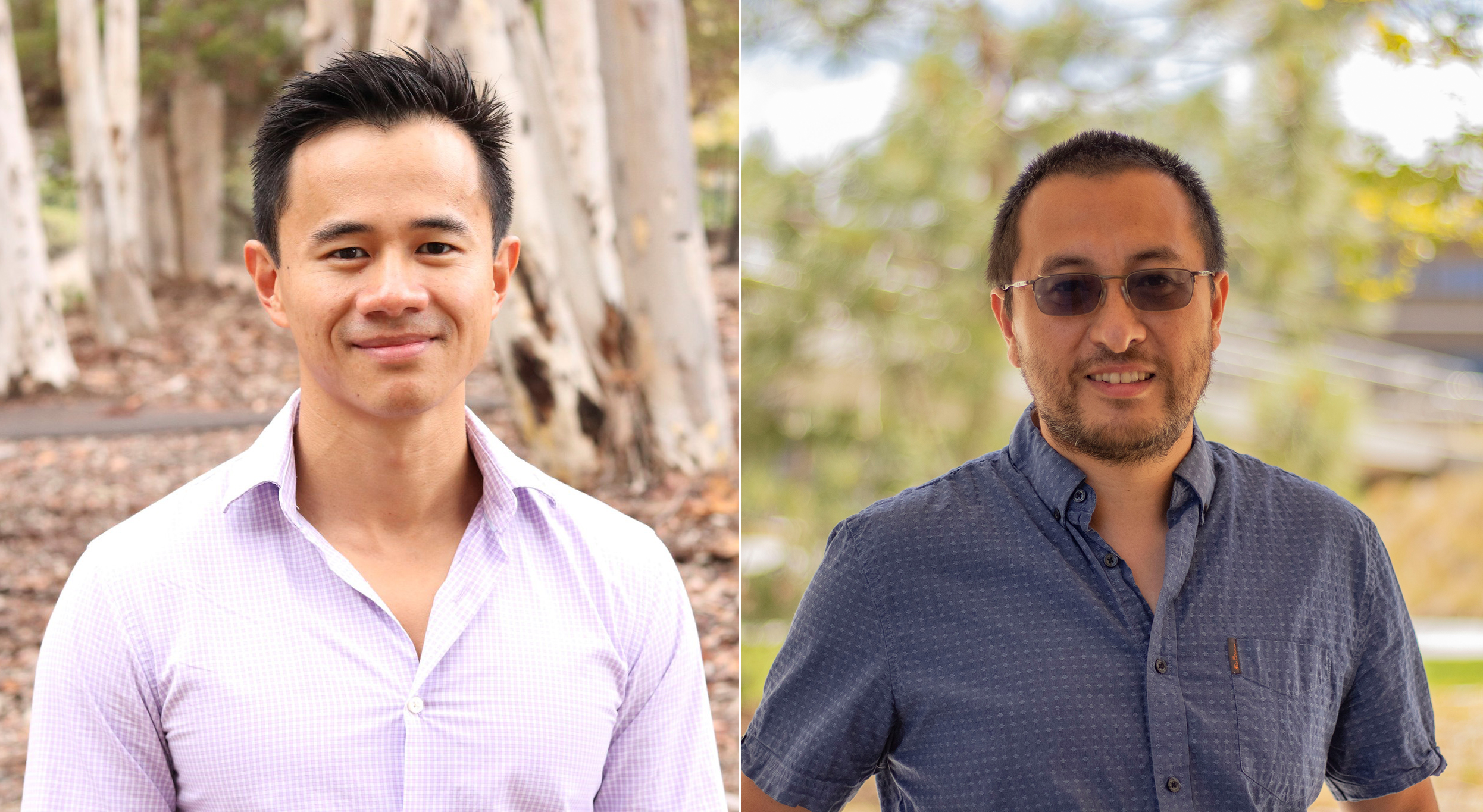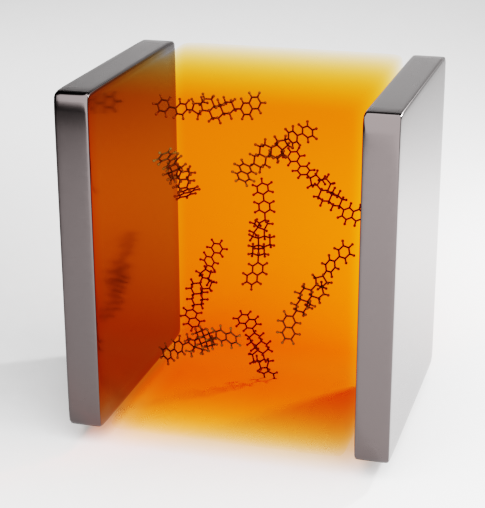The Science of…Polariton Chemistry
October 11, 2022 | By Michelle Franklin
Earlier this year, UC San Diego announced that Professors of Chemistry Wei Xiong and Joel Yuen Zhou received a $7.5 million Department of Defense MURI award to research polariton chemistry. In this edition of “The Science Of…” Wei and Joel explain what polariton chemistry is, what they hope to learn from their investigations and why chemistry is like magic.

Q: Before we discuss polaritons, let’s talk about your area of study. Wei, you are a physical chemist and, Joel, you’re a theoretical chemist. Can you explain what this is and what kind of work you do?
Wei Xiong: A physical chemist cares less about what and more about why. Why did a certain chemical reaction happen or not happen? We use physical methods and principles, including microscopy and ultrafast spectroscopy, to learn about molecular structures, dynamics and mechanisms.
Joel Yuen Zhou: In a way, theoretical chemists are like “fake chemists” because we work with equations and computers, instead of with beakers and substances. We want to understand and predict chemical behavior using theoretical tools. The bread-and-butter of my group is light-matter interactions and chemical reactivity.

Q: What is polariton chemistry?
JYZ: Imagine you have a molecule trapped between two mirrors — an optical cavity — and then suppose you shine light into the cavity, so the photons bounce back and forth between the mirrors. There is a probability that the photon and molecule will interact — the smaller the cavity, the higher the probability. Now, the energy states of the system are so-called polaritons, which are quantum mechanical combinations of light (photon) and matter (molecule).
Q: This MURI award is multidisciplinary — not just because researchers at several universities are participating, but also because it involves chemistry, physics and engineering. Can you explain this?
WX: In chemistry, photons are used as a probing tool, meaning they only perturb molecules by exciting them slightly out of equilibrium, instead of completely changing them. The concept of polaritons is based in physics. The idea is that now the photon and matter are coupled strongly, or non-perturbatively, so it creates a new state that is a hybrid of light and matter. Although the idea has been around for a long time, it hasn’t been considered whether you can change chemical reactions with polaritons. That’s what we’re investigating.
As Joel said before, the smaller the optical cavity, the more likely the photon and molecule will interact. And by small, we mean at the micro-level, not the nano-level (for comparison, the width of a human hair is around 50 microns, a strand of DNA is 2.5 nanometers wide). Engineers are really good at making photonic environments of this size; they’re already doing something at a similar scale for semiconductors.

Q: The Xiong lab runs experiments, and the Yuen Zhou lab explores theories. How will your labs work together on this MURI project?
JYZ: Wei and I have had a good collaborative relationship for the last 4-5 years. Our lab is interested in experiments, but it’s not something we do. Wei, on the other hand, is a tremendous experimentalist. But it’s not just the two of us. We have colleagues from around the nation and everyone brings unique talents to the project.
WX: One of the things we’re trying to do with polariton chemistry is create molecules with different characteristics, which are discernible using spectroscopy. You can’t run experiments on every possible permutation, so Joel’s lab will help develop theories to explain why certain reactions happen under certain conditions.
Q: How did you get interested in this work?
JYZ: I love photons. They are kind of like magic wands. Molecules are hard to manipulate, but photons are easier to control, and they can do really cool things. There have been so many advances in what can be done with photons over the past 70 years — a development that stems from physics and electrical engineering. As chemists, we want to exploit these advances to tame and understand molecules.
WX: The work I do now involves spectroscopy — looking at the color signatures of molecules to determine their characteristics. It’s interesting because I first became interested in chemistry when I saw that you could mix two substances together to create a new color — it looked like magic to me. Later, I learned that every molecule has their own color features, the so-called spectroscopy. From this, I can learn the structures and dynamics of molecules, which is essential to address the “why” questions.
Q: What are some potential uses for polaritons in the future?
WX: We know light travels fast. Electrons are much slower, but they are the key to electronics. Can we use polaritons, which possess the light, fast character of photons, to replace electronics? This is one area we are exploring in addition to polariton chemistry. Photons are more economical and energy-efficient than electrons. Ultimately this may be a way to improve efficiency and cost of electronic systems.
JYZ: The goal of this MURI is to understand how to control chemistry with polaritons. This field is still in the making, but we believe there is much promise on this regard.
Q: Joel, your lab recently published a paper on polariton condensates. What are those?
JYZ: Bose-Einstein condensates are a state of matter that can typically be created at ultracold temperatures. In this ultracold regime, all atoms synchronize and enter into the same quantum state. However, this regime is expensive and requires elaborate experimental cryogenic equipment. Polariton condensates, however, are cousins of the original Bose-Einstein condensates, and can be created under milder conditions, at room temperature using optical cavities and strong laser pumping. While polariton condensates have been in the limelight of the condensed matter physics community for two decades, no one had looked at them from a chemical viewpoint, and it turns out that they have very interesting chemical properties! I’ve very proud of my students for the work they did on this paper.

Q: What does a typical day or week in your lab look like?
WX: Most of the experimental work in my lab is done by students and postdocs. They’ll come in, turn on the lasers, prepare some samples, have some tea or coffee, and then run the experiments and start collecting data. They’ll discuss the data analysis with me; we’ll form a new hypothesis; and then they perform a new experiment. Sometimes I go to the lab myself to observe the experiments. Our labs are in the basement because the lasers we use are sensitive to floor vibrations, so I also encourage everyone to go outside for lunch.
JYZ: Everything in our lab is theoretical. Some people are reading research papers, some are writing equations, some run computer simulations. We all discuss what we think should happen and make theories based on those discussions. Then we test them with simulations. Essentially, we’re just a bunch of nerds working in the office, discussing physics and chemistry and trying to use math and computers to make sense of molecular processes.
